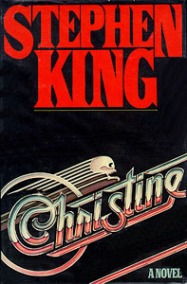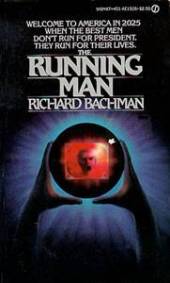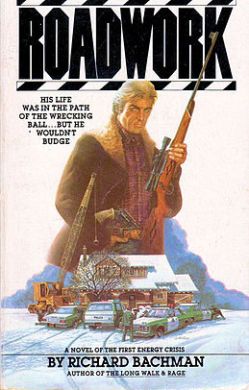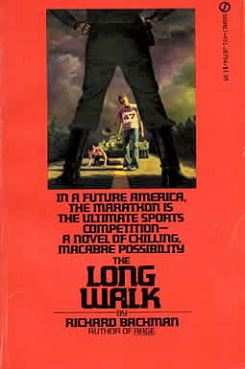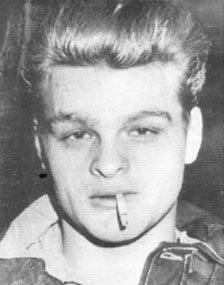There were two main reasons why I decided to read Christine. Firstly, since I began my Stephen King reading journey, I’ve been discussing his books with a colleague at work who has been reading King for literally decades. She recommended Christine and said she just found the concept of an inanimate object becoming possessed fascinating. Secondly, if you’ve read my blog about It, you’ll know how much I love the story – It is probably the best King book I’ve read (so far). Christine makes an appearance in It so this made me intrigued about the book. I am not going to go into detail about the story itself because I want to focus on how this book is connected to King’s other work and his overall cosmology. I have not yet read The Dark Tower series so much of King’s cosmology is still unknown to me however as I am reading his work I am making connections to his key concepts.
So who (or what) is Christine? Christine is a car, a red and white 1958 Plymouth Fury to be precise. The year 1958 (1957 – 58) reoccurs in Stephen King’s books and to me the year is a clear connection between Christine and It. I wouldn’t be so bold as to say Christine is the prequel to It but the entity possessing Christine (and LeBay) in my mind is the same as the entity – or certainly a manifestation – of It.
Although Christine is a 1958 Plymouth Fury, she was actually manufactured in 1957. It, the book, is set in two times periods, 1957 – 58 and 1984 – 85, so Christine’s existence corresponds with Its first time period. If the entity that possesses Christine is the same as It, what is It exactly? It (also referred to as Pennywise and Bob Gray) apparently originated in a void containing and surrounding the Universe. It arrived in our world in a massive, cataclysmic event similar to an asteroid impact, in the place that would, in time, become Derry, Maine. It arrived on earth in prehistoric times and existed before our universe was created by the Turtle who is his natural enemy.
Chronologically, It comes after Christine however I read It first. When I read the passage below from Christine, the connection was confirmed. The passage is the aftermath of when Christine, with the help of the corpse of Lebay, kills Buddy:
“From the far side, Christine’s engine ranked up into an exhaust-crackling bellow of triumph that struck the frowning, snow-covered uplands of Squantic Hills and then echoed back.
“On the far verge of Squantic Lake, some ten miles away as the crow flies, a young man who had gone out for a cross-country ski by starlight heard the sound and suddenly stopped, his hands on his poles and his head cocked.
“Abruptly the skin on his back prickles into bumps, as if a goose had just walked over his grave, and although he knew it was only a car somewhere on the side – sound carried a long way up here on still winter nights – his first thought was that something prehistoric had awakened and had tracked its prey to earth: a great wolf, or perhaps a sabre-toothed tiger.
“The sound was not repeated and he went on his way.”
I interpreted this passage to reveal that the young man who heard Christine, intuitively felt that the entity was prehistoric. The young man heard Christine when the entity had just killed Buddy. I am of the opinion that the entity that possessed LeBay and Christine is the same entity as It. I haven’t heard this theory bandied about by other Stephen King readers, I came up with the theory myself so I haven’t fully developed it or worked out its significance.
Christine was first published in 1983, the film was released the same year, so this year celebrates its 30th anniversary. Below is a link of an interview Stephen King had with Randy Lofficier in 1984 about Christine:
http://appleworld.ekmdigitalvault.com/DVPublic/appleworld/PAF/CHRISTINE-INTERVIEW.pdf
The interview gives great incite to King’s intentions when wrote Christine. King is asked whether Christine is evil herself, of whether LeBay makes her evil. King replied that this was an issue ‘the film people’ wrestled with and decided that the car itself was the source of evil. In contrast to the film, King stated the book suggests that it’s probably LeBay. As I’ve already stated, I think the source is much bigger and older than LeBay!
I really enjoyed the film and loved the theme tune! The story is slightly altered, but compared to other King adaptations, it’s not bad. I definitely recommend watching the film after reading the book! The book does drag in parts however it is definitely worth pursuing to the end! I enjoyed Christine, it’s not King’s best book but it’s a must read as Christine plays an iconic role making numerous appearances in the universe of Stephen King.
